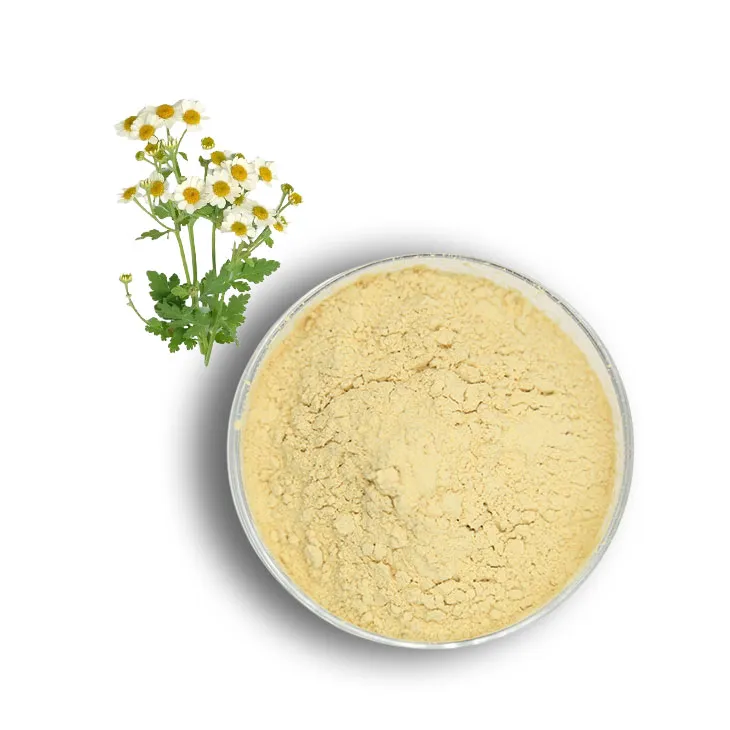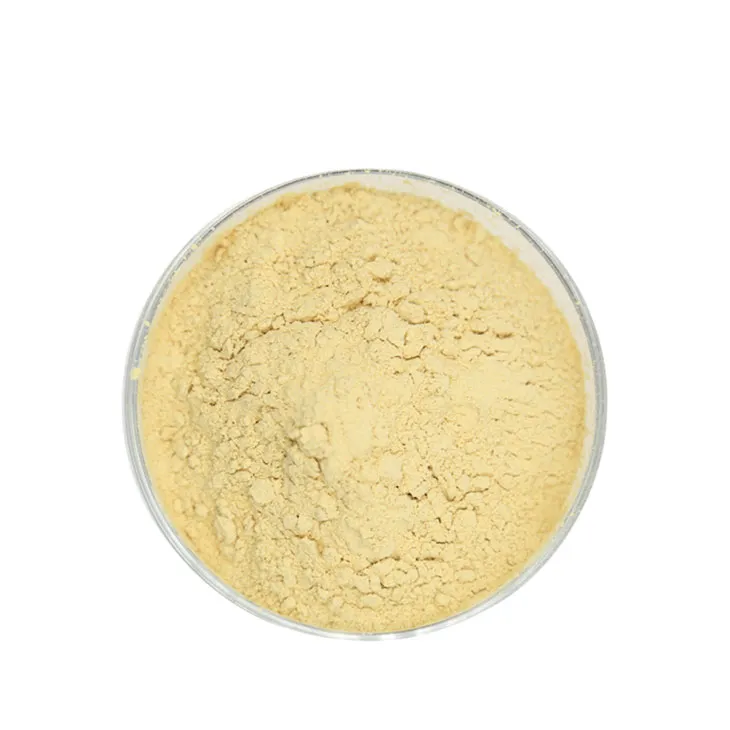- 0086-571-85302990
- sales@greenskybio.com
Best Answers to 7 Key Questions about Feverfew Extract.
2024-12-16

1. Production Origin
Feverfew, the plant from which the extract is derived, has a relatively wide production origin. It is native to southeastern Europe and Asia Minor. However, it has been naturalized in many other regions around the world due to its popularity and the demand for its extract.
Key Regions of Production
- Europe: Countries such as Greece, Italy, and Serbia have suitable climates for feverfew growth. The Mediterranean climate in parts of Europe provides the warm, sunny days and well - drained soil that feverfew prefers.
- North America: In the United States, particularly in some states with temperate climates, feverfew is cultivated. For example, parts of California and Oregon have seen successful cultivation of feverfew.

2. Main Components in its Chemical Structure
Feverfew Extract contains several important chemical components that contribute to its properties. One of the major components is sesquiterpene lactones, particularly parthenolide. Parthenolide is believed to play a significant role in many of the biological activities associated with feverfew.
Other components include:
- Flavonoids: These are a diverse group of polyphenolic compounds. In feverfew, flavonoids contribute to its antioxidant properties. For example, apigenin and luteolin are flavonoids found in Feverfew Extract. They help in scavenging free radicals in the body, which can reduce oxidative stress.
- Volatile Oils: These oils give feverfew its characteristic smell. They also have potential biological activities. Some of the volatile oils in feverfew may have antimicrobial properties, helping to prevent the growth of certain microorganisms.

3. Positive Effects on Health
Feverfew Extract has been associated with several positive effects on health.
3.1 Headache and Migraine Relief
One of the most well - known uses of feverfew is for the relief of headaches and migraines. Some studies suggest that the parthenolide in feverfew may help reduce the frequency and severity of migraines. It is thought to work by inhibiting the release of certain substances in the body that can trigger migraines, such as serotonin and prostaglandins.
3.2 Anti - Inflammatory Properties
The sesquiterpene lactones and flavonoids in feverfew extract have anti - inflammatory effects. They can help reduce inflammation in the body, which is beneficial for conditions such as arthritis. By reducing inflammation, feverfew may help relieve pain and improve joint function in arthritis patients.
3.3 Antioxidant Activity
As mentioned earlier, the flavonoids in feverfew act as antioxidants. Antioxidants are important for maintaining the health of cells in the body. They can protect cells from damage caused by free radicals, which are unstable molecules that can damage DNA, proteins, and lipids. By reducing oxidative stress, feverfew may have a role in preventing chronic diseases such as cancer and heart disease.

4. Associated Risks
While feverfew extract has many potential benefits, there are also some associated risks.
4.1 Oral Health Risks
When taken orally, feverfew can sometimes cause side effects in the mouth. Some people may experience mouth ulcers or irritation. This is thought to be related to the chemical components in feverfew, particularly the sesquiterpene lactones. It is important for users to be aware of these potential oral health risks and to stop using the extract if they experience any such problems.
4.2 Allergic Reactions
Like many plant - based extracts, feverfew can cause allergic reactions in some individuals. Symptoms may include skin rashes, itching, and in severe cases, difficulty breathing. People with known allergies to plants in the Asteraceae family (which feverfew belongs to) are at a higher risk of having an allergic reaction to feverfew extract.
4.3 Interaction with Medications
Feverfew may interact with certain medications. For example, it may increase the risk of bleeding when taken with blood - thinning medications such as warfarin. It is crucial for patients taking any medications to consult their doctor before starting to use feverfew extract to avoid any potential adverse drug interactions.

5. Utilization in the Cosmetic Industry
Feverfew extract has found its way into the cosmetic industry due to its beneficial properties.
5.1 Skin Health
The antioxidant and anti - inflammatory properties of feverfew make it a valuable ingredient in skin care products. It can be used in creams, lotions, and serums to help protect the skin from environmental damage, such as damage from UV rays and pollution. By reducing inflammation in the skin, it can also be helpful for conditions such as acne and eczema, improving the overall appearance and health of the skin.
5.2 Hair Care
In hair care products, feverfew extract can help improve the health of the scalp. Its anti - inflammatory properties can be beneficial for reducing scalp inflammation, which can be a cause of dandruff. Additionally, the antioxidant properties may help protect the hair follicles from damage, promoting healthier hair growth.

6. Medical Uses
Beyond its uses for headache and migraine relief, feverfew extract has other potential medical applications.
6.1 Digestive Health
Feverfew has been traditionally used to aid in digestive health. It may help relieve symptoms of indigestion, such as bloating and stomach pain. Some studies suggest that it can help regulate the digestive system by affecting the movement of the intestines and the secretion of digestive enzymes.
6.2 Women's Health
In women's health, feverfew may have potential applications. Some research has explored its use in relieving menstrual cramps. The anti - inflammatory and pain - relieving properties of feverfew may help reduce the pain and discomfort associated with menstrual periods.
7. Extraction Techniques
There are several methods for extracting feverfew extract, each with its own advantages and disadvantages.
7.1 Solvent Extraction
Solvent extraction is a commonly used method. In this process, a suitable solvent, such as ethanol or methanol, is used to dissolve the active components from the feverfew plant material. The plant material is soaked in the solvent for a period of time, and then the solvent is evaporated to obtain the extract. However, one drawback of this method is that it may leave behind traces of the solvent in the final extract, which may be a concern for some applications.
7.2 Supercritical Fluid Extraction
Supercritical fluid extraction uses a supercritical fluid, typically carbon dioxide, as the extracting agent. The supercritical carbon dioxide has properties that allow it to efficiently extract the desired components from the feverfew. This method has the advantage of being a "cleaner" extraction method as it leaves no solvent residues. However, it requires specialized equipment, which can be expensive.
7.3 Steam Distillation
Steam distillation is mainly used to extract the volatile oils from feverfew. In this method, steam is passed through the plant material, and the volatile oils are carried along with the steam. The mixture is then condensed, and the oils are separated from the water. While this method is effective for extracting volatile oils, it may not be as efficient for extracting other components such as the sesquiterpene lactones.
FAQ:
What is the production origin of white chamomile extract?
White chamomile is native to parts of Europe and Asia. It is mainly produced in regions where the climate is suitable for its growth, such as some areas in the Mediterranean. The plants are carefully cultivated and then harvested for the extraction process. High - quality white chamomile extract often comes from areas with good agricultural practices and proper environmental conditions to ensure the purity and potency of the extract.
What are the main components in the chemical structure of white chamomile extract?
White chamomile extract contains several important components. One of the key components is chamazulene, which gives the extract its characteristic blue color. It also contains bisabolol, which has anti - inflammatory properties. Additionally, flavonoids are present in the extract. These components work together to contribute to the various properties and potential benefits of white chamomile extract.
What are the positive effects on health of white chamomile extract?
White chamomile extract has multiple positive effects on health. It has anti - inflammatory properties, which can be helpful in reducing inflammation in the body, such as in cases of skin inflammation or minor internal inflammations. It also has a calming effect and can be used to relieve stress and anxiety. Moreover, it may have some digestive benefits, potentially helping with indigestion and soothing the digestive tract.
What are the associated risks of using white chamomile extract?
While white chamomile extract is generally considered safe for most people, there are some associated risks. Some individuals may be allergic to it, especially those with known allergies to plants in the daisy family. In rare cases, excessive use may lead to skin irritation or digestive discomfort. Pregnant women should also be cautious when using white chamomile extract as its effects on pregnancy are not fully understood.
How is white chamomile extract utilized in the cosmetic industry?
White chamomile extract is widely used in the cosmetic industry. It is often added to skincare products such as creams, lotions, and serums. Due to its anti - inflammatory and calming properties, it can be used to soothe irritated skin, reduce redness, and improve the overall appearance of the skin. It is also used in haircare products, as it may help to soothe the scalp and add shine to the hair.
What are the medical uses of white chamomile extract?
In the medical field, white chamomile extract has been used for various purposes. It can be used topically to treat minor skin wounds and burns as it promotes healing. Internally, it may be used in some herbal remedies to relieve menstrual cramps or as a mild sedative. However, it should not be used as a substitute for proper medical treatment without consulting a healthcare professional.
What are the extraction techniques for white chamomile extract?
There are several extraction techniques for white chamomile extract. One common method is steam distillation, which is used to extract the essential oils from the chamomile flowers. Another method is solvent extraction, where solvents are used to dissolve the active components from the plant material. Maceration, which involves soaking the plant material in a solvent for a period of time, is also a possible extraction technique. The choice of extraction technique depends on the desired components and the end - use of the extract.
Related literature
- The Chemistry and Pharmacology of White Chamomile Extract"
- "White Chamomile Extract: Production, Properties and Applications"
- "Health Benefits and Risks Associated with White Chamomile Extract"
- ▶ Hesperidin
- ▶ citrus bioflavonoids
- ▶ plant extract
- ▶ lycopene
- ▶ Diosmin
- ▶ Grape seed extract
- ▶ Sea buckthorn Juice Powder
- ▶ Beetroot powder
- ▶ Hops Extract
- ▶ Artichoke Extract
- ▶ Reishi mushroom extract
- ▶ Astaxanthin
- ▶ Green Tea Extract
- ▶ Curcumin Extract
- ▶ Horse Chestnut Extract
- ▶ Other Problems
- ▶ Boswellia Serrata Extract
- ▶ Resveratrol Extract
- ▶ Marigold Extract
- ▶ Grape Leaf Extract
- ▶ blog3
- ▶ blog4
- ▶ blog5
-
Pure 85% Tomentil Extract.
2024-12-16
-
Coix Seed Extract
2024-12-16
-
Horse Chestnut Extract
2024-12-16
-
Angelica sinensis extract
2024-12-16
-
Bitter Melon Extract
2024-12-16
-
Natural grape seed extract
2024-12-16
-
Baicalin
2024-12-16
-
Wheat Germ Extract
2024-12-16
-
Lemon Extract
2024-12-16
-
Kelp Extract Powder
2024-12-16
-
Soy Extract
2024-12-16





















